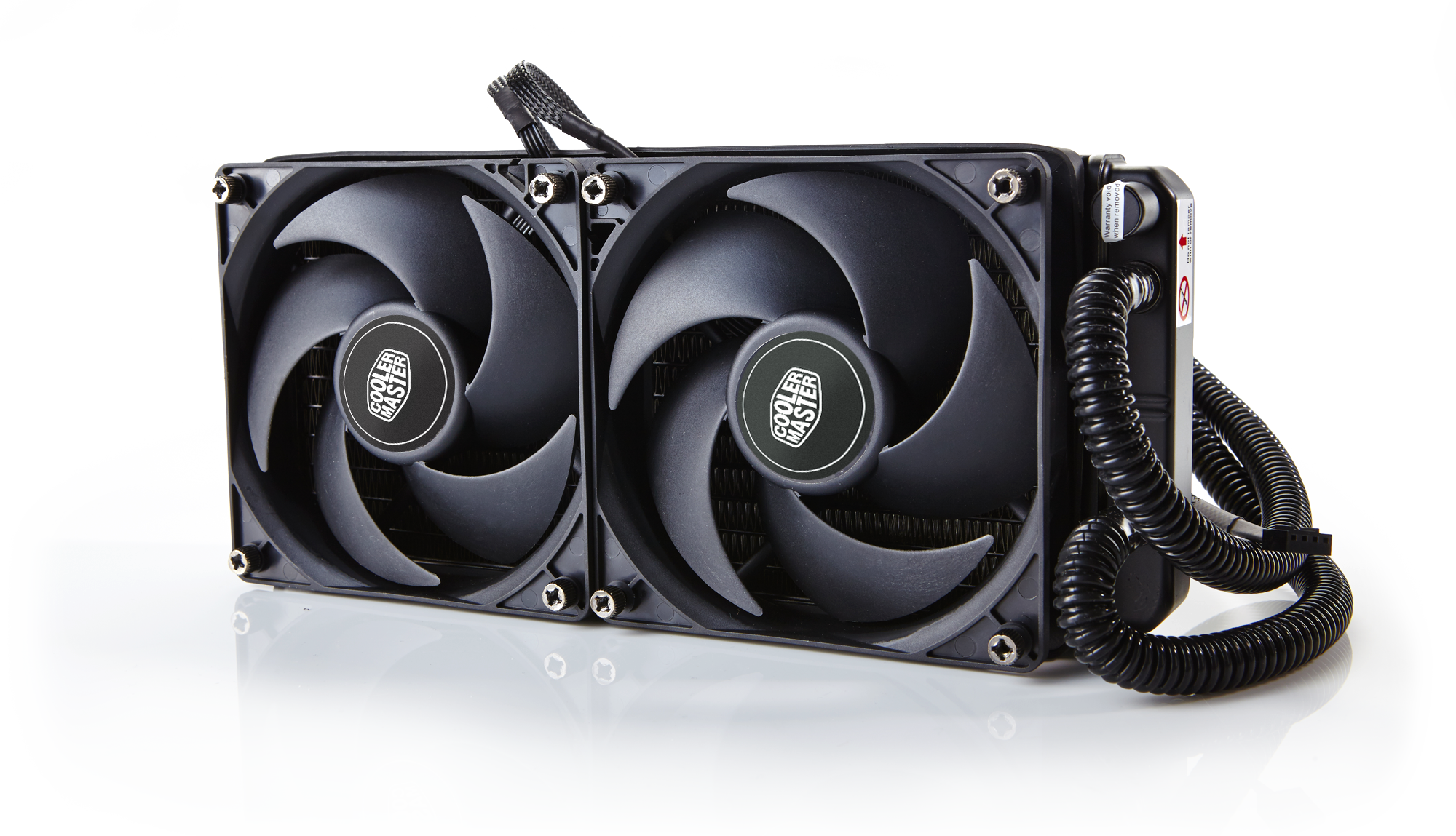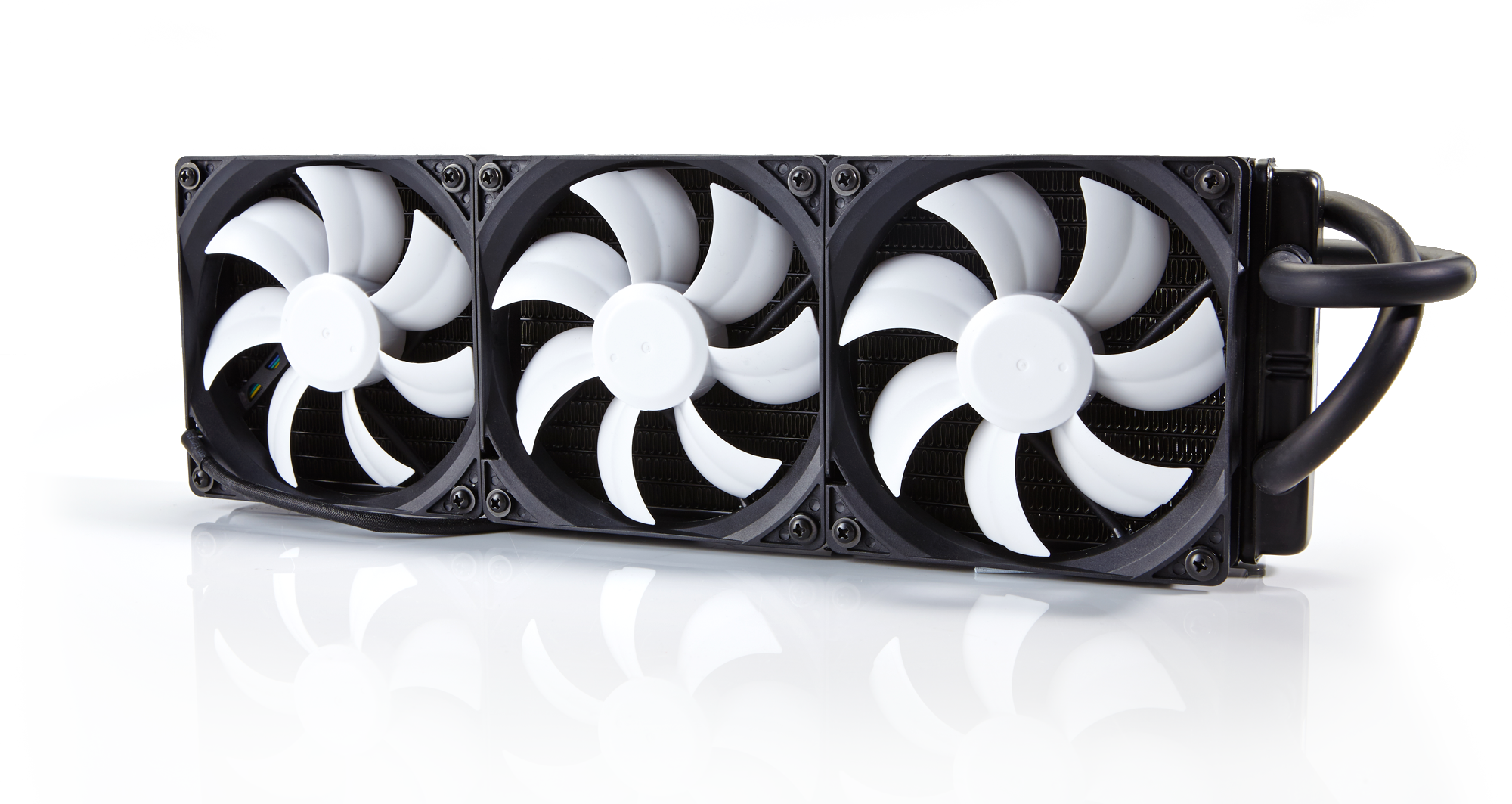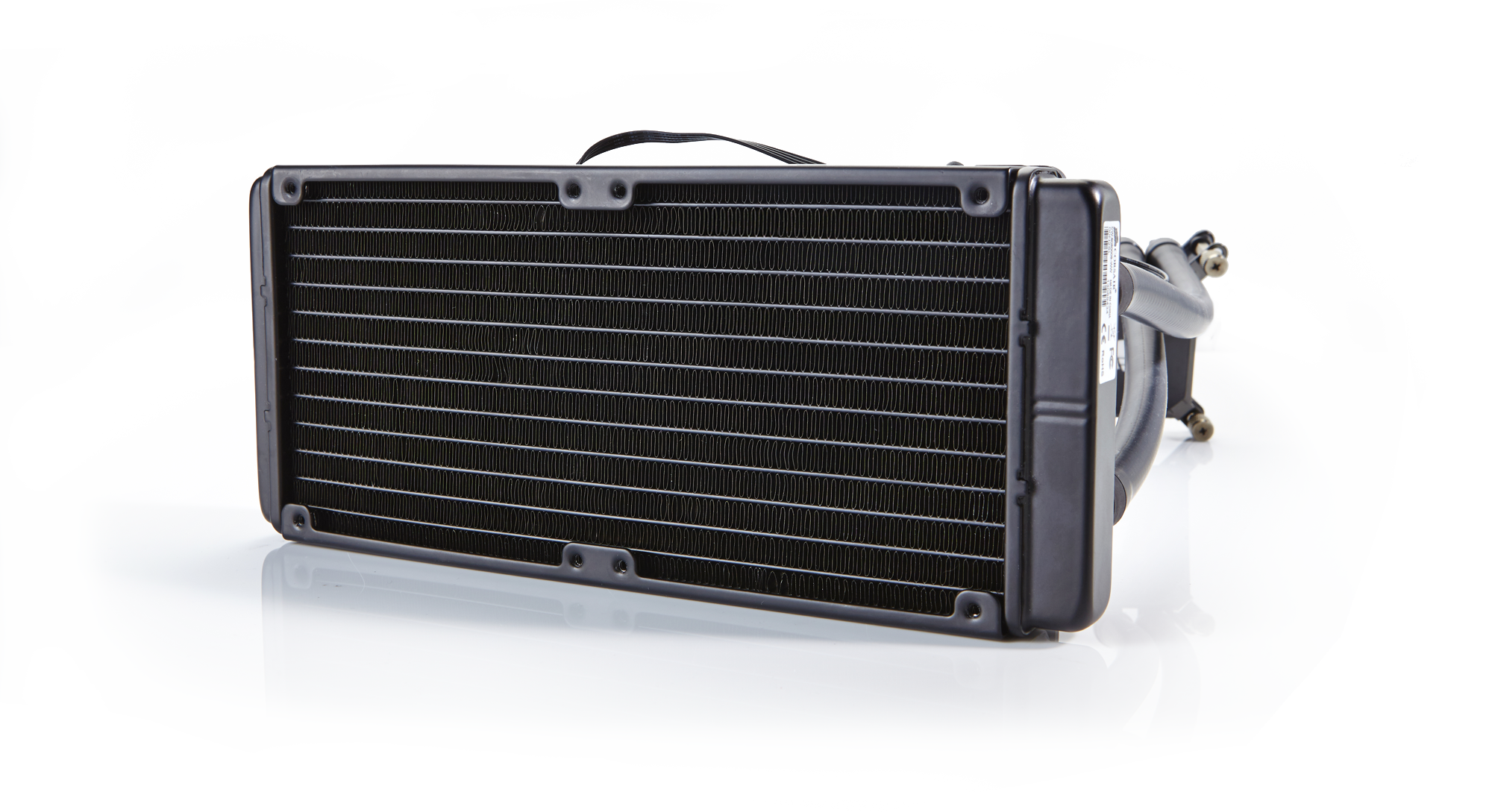Closed-loop liquid cooler roundup: 8 coolers reviewed

Cooler Master Nepton 240M
Radiator size: 240mm
Radiator thickness: 27mm
Fans: 2x 120mm PWM
Motherboard connections: 2x 4-pin
When you’re talking about cooling you might as well go to the masters, right? I mean, it’s not just a clever name; they’ve been in the cooling business since Methuselah was in short pants. This month's test turned out to be a close run between Thermaltake’s massive 360mm cooling radiator and this new Cooler Master design. It’s been a very tight fight.
The new $115 Cooler Master Nepton 240M (£78) takes the win thanks to the almighty combination of smart design, fiddle-free fitting and some excellent cooling performance. Not to mention the fact those chunky fans are practically silent, even when running my processor at 4.5GHz.
Having spent a month unpacking, screwing together and fitting all these water-coolers, it was a blessed relief to finally come to the Nepton. Connecting it is a cinch. Both the 120mm version and this larger cooler have the same setup, and it’s really well-designed. Their older Seidon sibling was my previous favourite liquid-chiller. It sat on my test rig churning through benchmarks for years before a colleague, who shall remain nameless, somehow yanked the wires out of it. Sad face. The Neptons share the same DNA with the old Seidons, but have refined the fitting process even more.
Like Corsair’s coolers, the Neptons use a bolted-on motherboard bracket. That’s really helpful when you’re attaching the cooler to an existing system; it means you should be able to fit the cooler with the motherboard still in the PC case, as there’s a big enough cut out behind the motherboard to screw in the mounting bracket. Then you can screw the Nepton in place without needing three hands. A loose-fit mounting bracket is either an exercise in solo juggling frustration or a two-person job.
The Neptons also use thumbscrews to fit the fans to the radiator—which itself has vibration-dampening rubber mounts—so attaching the twin spinners is much simpler. You can tell a regular system-builder designed this setup because it doesn’t force you into any strange contortions to get it in place.
So, it’s a joy to fit, but how does it perform? Well, it’s not the absolute best in terms of straight cooling performance—Zalman’s freaky-looking Reserator 3 Max Dual takes those honours—but it’s not far off that peak performance. Where it really shows its chip-chilling skills is in the time it takes to return a processor, overclocked or not, to its idle temperature. If you can get under ten seconds at stock speeds you’ve nailed it, and at 8 seconds the Nepton 240M is impressively quick.
Overclocked it only takes 15 seconds. Thermaltake’s Water 3.0 needs an awkwardly-long, 360mm radiator to get to that sort of timing.
Keep up to date with the most important stories and the best deals, as picked by the PC Gamer team.
That’s why, for me, Cooler Master beats Thermaltake here—their 240mm radiator cools well and is far more likely to fit in your chassis than the 360mm behemoth. It’s also a pretty svelte radiator, yet another tick for its many boxes. And considering the performance is so close, and the price a lot lower, it’s a win for the masters of cooling. If you’re looking for a closed-loop liquid chip chiller, the best we've tested so far is the Nepton 240M.
Score: 91%
Verdict: A quality, easily-fitted cooler, that’s got great performance to boot.

Thermaltake Water 3.0 Ultimate
Radiator size: 360mm
Radiator thickness: 27mm
Fans: 3x 120mm PWM
Motherboard connections: 2x 4-pin
It all started with 120mm water-coolers to match the 120mm fans on our normal air coolers. Then we moved on to double-length, 240mm coolers because we managed to find space in our high-spec chassis to fit them. Where do you go from there? Well, why not three fans?
‘I likes em big,’ admitted one Benny Hill fan in the Thermaltake skunkworks, and so was born the $140 Water 3.0 Ultimate (£113). The 360mm radiator is quite astounding to behold and means you’re going to have to get serious with the tape measure to make sure it’ll fit inside your current chassis. You’re likely to have to wave goodbye to your 5.25-inch optical drive as the Water 3.0 Ultimate is going to want that space for itself.
But, if you’ve got the space, Thermaltake’s big boy will deliver the chip-chilling goods. It’s the best-performing cooling array I’ve tested this month, neck-and-neck with the ever-so-slightly cooler Zalman in the peak temperature measurements. But it’s so close as to be almost meaningless in the final reckoning.
The real key to this cooler, and the thing that justifies that monstrous cooling radiator, is the peak-to-idle timings of the Water 3.0 Ultimate. Whether your CPU is overclocked or resting on its stock-clocked laurels it will return your processor to its thumb-twiddling temps as close to instantaneously as you’re going to get right now. It took just four seconds at stock speeds and only thirteen seconds after cooking the chip at 4.5GHz.
It’s also well-designed, with a slightly improved backplate over the other Water 3.0 cooler we'll get to later. Those fans are remarkably quiet too, even when the chip is being thrashed. As I said, it was close to being the winner. Sadly, because of the Water 3.0's awkward size and expense, it just slips into second place.
Score: 89%
Verdict: Fantastic-performing cooler, but too big for many chassis and a little pricey too.

Zalman Reserator 3 Max Dual
Radiator size: 240mm
Radiator thickness: 73mm
Fans: 2x 120mm PWM attached
Motherboard connections: 1x 3-pin, 1x 4-pin
Zalman is a name that’s been synonymous with PC cooling for as long as I can remember and most especially water-cooling. My first experience with a water-cooled PC was an old external radiator called the Reserator. It dwarfed any PC chassis plumbed into it; looking like something ripped directly out of the Death Star before it became fully operational. It was all rather impractical for home use, looked absolutely bonkers but was very good at what it did.
Rather like its current-day namesake. The $140 Reserator 3 Max Dual (£99) looks as different from the other coolers in this test as the original did to any other cooler on the market at the time. There is no radiator as we know it. The tubes carrying the heated coolant from the CPU contact plate flow directly into an intricate swirl of aluminium heatpipes, encircled by hundreds of fins drawing out the heat before the chilled liquid flows back to the processor.
I was hoping the fact the fans are attached would make it a quick job to fit, but putting together the mounting bracket for the motherboard took an age and a million tiny screws. The bracket is another loose-fit one too, which took a certain amount of juggling to attach even on an open test bench. Don’t get me started on the bizarre contraption you’re expected to build to actually get it attached to your PC case. It just seems needlessly complicated compared to the rest of the crowd.
But Zalman are long-time cooling experts and they certainly know what they’re doing, because the Reserator 3 posts the lowest temperatures of all the models here, even compared with the mammoth Thermaltake. What it can’t do, however, is shift the heat away quite as quickly. The peak-to-idle times of the Reserator 3 certainly aren’t bad, but either side of thirty seconds for both stock and overclocked performance isn’t class-leading. It’s also mighty expensive too, which, along with the awkward case-fitting, means the Reserator 3 slides back down the pecking order despite its impressive cooling performance.
Score: 87%
Verdict: Serious cooling performance, but a little slow on the peak-to-idle and awkward to connect to your case.

Corsair H100i
Radiator size: 240mm
Radiator thickness: 27mm
Fans: 2x 120mm PWM
Motherboard connections: 1x 3-pin, 1x 4-pin, 1x USB
Corsair’s $100 H100i (£84) is an oldie, but a goodie. It’s been around seemingly forever, but manages to keep up with the young'uns even today. It’s a testament to Corsair’s powers of design that they’ve barely had to change its setup since the original H100. Subsequently there have been H105 and H110 updates, but I’m still a big fan of the solid motherboard bracket and bless them for letting it be bolted onto the board itself.
I also really like the two magnetic brackets that slips over the top of the pump, making the universal fitting so much easier than most. All the coolers in the test are compatible with either AMD or Intel PCs, but it’s a more elegant solution. It’s these little design touches that separate the Corsair coolers from a lot of the other, more off-the-shelf setups.
The H100i also incorporates the Corsair Link technology. Corsair make so many PC components they’ve created components that can communicate with each other. If you’ve got a Corsair case and Corsair cooler you can plug your case fans into the pump and, via the USB cable attached to it, control them all using the Link software. It’s smart, but you could lose many days trying to perfect your setup, especially with all the fan curves and profiles you can create.
Unfortunately the stock performance isn’t amazing. All the coolers in this test work very well indeed, but the H100i isn’t able to top the charts when it comes to either peak cooling performance of the peak-to-idle timings. Surprisingly though it’s actually quicker when there’s a bigger delta between the peak and idle temperatures, dropping the temperature in just 21 seconds when overclocked. That’s good, but still puts it in third place on that score.
Considering there’s not a lot of difference between the H100i and the superior Cooler Master Nepton 240M, that’s where I’d be putting my own money. They’ve both got solid mounting designs, but the slightly better cooling performance of the Nepton seals it for me.
Score: 84%
Verdict: Still a quality cooler, with smart control software, but isn’t quite top of the class in performance.
| Cooler | 100% CPU turbo (3.9 GHz) | 100% CPU turbo (4.5GHz OC) | Peak-to-idle time (OC) |
|---|---|---|---|
| Cooler Master Nepton 240M | 53°C | 62°C | 15 seconds |
| Thermaltake Water 3.0 Ultimate | 50°C | 60°C | 13 seconds |
| Zalman Reserator 3 Max Dual | 50°C | 59°C | 32 seconds |
| Corsair H100i | 54°C | 66°C | 21 seconds |
| Antec Kuhler H20 950 | 57°C | 69°C | 84 seconds |
| Cooler Master Nepton 120XL | 55°C | 66°C | 172 seconds |
| Thermaltake Water 3.0 Pro | 50°C | 61°C | 46 seconds |

Dave has been gaming since the days of Zaxxon and Lady Bug on the Colecovision, and code books for the Commodore Vic 20 (Death Race 2000!). He built his first gaming PC at the tender age of 16, and finally finished bug-fixing the Cyrix-based system around a year later. When he dropped it out of the window. He first started writing for Official PlayStation Magazine and Xbox World many decades ago, then moved onto PC Format full-time, then PC Gamer, TechRadar, and T3 among others. Now he's back, writing about the nightmarish graphics card market, CPUs with more cores than sense, gaming laptops hotter than the sun, and SSDs more capacious than a Cybertruck.

